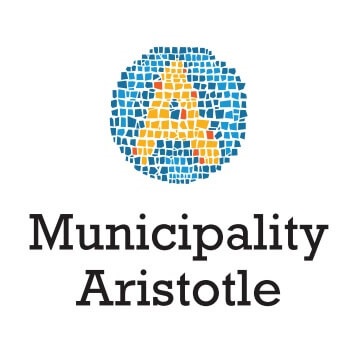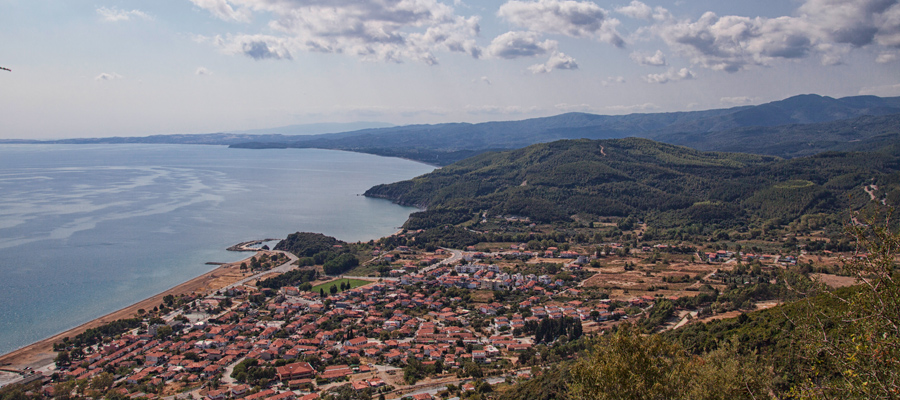«Οι κάβες της Γερακινής και το Στρατώνι…»
Ν. Καββαδίας, Φάτα Μοργκάνα
Stratoni is a coastal village located at the head of the bay of Ierissos, with over 1,200 inhabitants (according to the 2011 census). Its foundation as a settlement dates back to the late 19th century and is closely related to the mining activities in the region. The rich deposits of mixed sulfide ores, known since antiquity and Byzantine times, became the main source of wealth for the village. From that time, people from surrounding areas, as well as from other parts of Greece, began gathering in Stratoni to work in the mines. The population increased significantly due to refugees who sought refuge here after the Asia Minor catastrophe. In 1932, the village suffered extensive damage from the earthquake centered in the bay of Ierissos. In the following years, it was almost entirely rebuilt.
The area has been inhabited since ancient times, and mining activity in Stratoni and the surrounding villages dates back to around 600 BC. Excavations in 1962 revealed that Stratoni was built on the site of the ancient city of Stratonikeia. This city is mentioned by Claudius Ptolemy, though he erroneously placed it in the Siggitic Gulf.
ARCHAEOLOGICAL FINDINGS
The history of the area is reflected in significant archaeological finds. In a private garden, a section of a marble votive relief was found, which is hosted in the archaeological museum of Polygyros and likely dates back to the early Roman period. It depicts a frontal female figure dressed in a long tunic, holding the Horn of Amalthea and a garment in her left hand. It is likely a representation of the goddess Isis-Tyche, referred to as the “Mistress of Stratoni.”
In 1962, during the excavation of water canals in front of the Kassandria Mines mutual aid fund, a rectangular building (10 x 6 meters) was found, with a north-south axis and an entrance from the south. It consists of a main room (5 x 5.50 meters) and an ante-room (5 x 3 meters) connected by a door 1.80 meters wide. The walls are preserved up to a height of 0.80 meters. Along the western wall, a marble sarcophagus (2.20 x 0.78 meters) was found. In the center of the northern wall of the main room, a pedestal was discovered. In front of it, a full-size female statue of about 2 meters in length was found in a prone position. Between the female statue and the sarcophagus, there was a headless male statue with drapery.
A third male torso was found, as well as a rectangular slab depicting a funeral banquet with the inscription “Nikoptelema of Epilycus, Heroine, greetings” and a male figurative head, which likely belongs to a torso from the Claudian period. Also, an epitaph with the inscription “Afthónetos Arissedios Tierteou” was found, along with another slab bearing the inscription “Herodorus Theagenus.” Within the room, a built-in chest-shaped tomb and an amphora with a sharp base containing minimal bones were discovered, suggesting a hero’s grave from the 1st century BC.
To the south of the village, on the slopes of the hills, Roman and later tombs were identified, along with the ruins of houses. Fragments from the Hellenistic and Byzantine periods, as well as a sealed amphora handle, were collected. From the courtyard of a house, four pieces of marble were collected that had recently broken and form the torso of a male statue.
To the south of the village, at the top of the first coastal hill, which is steep on the sea side and covered with olive trees, a built tomb with a vaulted roof was discovered. It measures 2.40 x 1.25 x 1.20 meters and is constructed with fired clay bricks. A rectangular niche opens on the narrow eastern side, surrounded by marble slabs. The floor consists of both clay and marble tiles. One clay tile bears rectangular imprints and a carved cross within them, with the letters of the word “THEOU” inscribed at each corner. The tomb was filled with bones, although they were not in their original position.
CULTURAL ACTIVITIES
The inhabitants of Stratoni, although originating from various regions, formed a unified, harmonious community and have always been distinguished by their love for culture. Throughout history, Stratoni has hosted numerous artistic events and local celebrations. These include the staging of theatrical performances (even before the war), the founding of a music and gymnastic club in the 1950s, painting exhibitions, the operation of a band and dance group, the organization of impressive carnival events, peace weekends, and concerts by major artists. These are just a few examples of the cultural tradition of Stratoni, which continues today through the activity of local associations.
THE ARTICLE



